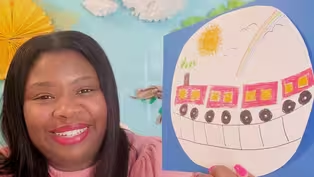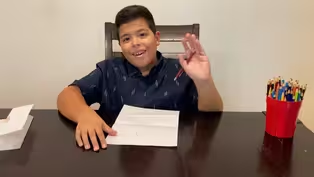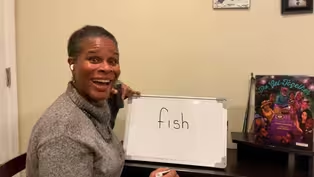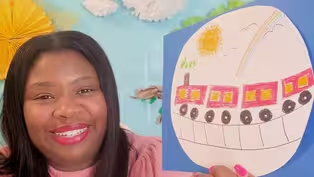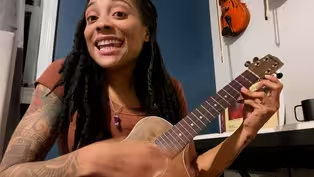
CARS ON RAMPS
Clip: 4/20/2023 | 8m 11sVideo has Audio Description, Closed Captions
Cassondra Easterling tests the speed of toy cars on a ramp.
Cassondra Easterling and her children use toy cars on cookie sheet ramps at different heights to explore the impact on vehicle speed. She adds fabric to the ramps, creating friction that slows the vehicles, and compares results.
See all videos with Audio DescriptionADProblems playing video? | Closed Captioning Feedback
Problems playing video? | Closed Captioning Feedback
Let's Learn is a local public television program presented by THIRTEEN PBS

CARS ON RAMPS
Clip: 4/20/2023 | 8m 11sVideo has Audio Description, Closed Captions
Cassondra Easterling and her children use toy cars on cookie sheet ramps at different heights to explore the impact on vehicle speed. She adds fabric to the ramps, creating friction that slows the vehicles, and compares results.
See all videos with Audio DescriptionADProblems playing video? | Closed Captioning Feedback
How to Watch Let's Learn
Let's Learn is available to stream on pbs.org and the free PBS App, available on iPhone, Apple TV, Android TV, Android smartphones, Amazon Fire TV, Amazon Fire Tablet, Roku, Samsung Smart TV, and Vizio.
Providing Support for PBS.org
Learn Moreabout PBS online sponsorship[cheerful folk music] - Hi, friends.
My name is Cassondra, and these are my helpers- - Noel.
- And Emry.
- And we're here today to do a fun science experiment with you.
Today, we are going to be talking about transportation.
Can you say that word?
- [Cassondra and Emry] Transportation.
- Say it one more time.
- [Emry and Noel] Transportation.
- Great.
Now, what is transportation?
- A way to get from one place to another.
- Excellent.
Transportation is how we get from one place to another place.
And there are different kinds of transportation.
Let's think of some different kinds of transportation.
For example, one kind of transportation is a boat.
Can you think of another kind of transportation?
- Maybe a car or maybe a bike.
- Maybe a car or a bike.
Great.
And how about you, Noel?
- Maybe walking.
- Maybe walking.
Great.
- Or a plane.
- Maybe an airplane, okay.
So those are some kinds of transportation.
Now, thinking about those kinds of transportation that we just said, some of them are fast and some of them are slow.
So we are going to sort some kinds of transportation, thinking about which ones are fast and which ones are slow.
So here's our first kind of transportation.
What is that?
- A bike.
- And is a bike fast or slow?
- Slow.
- Slow?
Okay.
Put it up on our chart.
How about this kind of transportation?
- It's a car.
- A car.
- A car.
Is a car fast or slow?
- Fast.
- All right, add it to our chart.
Okay, now how about this one?
What kinda transportation is this and is it fast or slow?
- A airplane.
- An airplane.
Is it fast or slow?
- Fast.
- Okay, can you add that to our chart?
And then how about this kind of transportation?
What is this person doing?
- Walking.
- Walking.
Is that fast or slow?
- Slow.
- Slow.
- Okay, slow.
Noel, can you add that to our chart?
All right, good.
Now let's think about how we said that a car is a fast kind of transportation.
Is a car always fast?
- No.
- When might a car not be fast?
- In a school zone.
- A school zone.
That's a great idea.
When a car is driving in a school zone, they have to go more slowly so that they can keep the kids safe.
Can you think of another time, Emry?
- Or maybe when there's traffic, you have to slow down so you don't get in an accident.
- Excellent.
So when there's traffic, you have to slow down so that you don't get in an accident.
That's a great idea.
So today, we're going do an experiment with a couple cars.
And we are going to be thinking about how these cars sometimes are gonna wanting to go faster, and sometimes they're going to go slower in our experiment.
And we're going to be using a ramp.
A ramp is something that we can use to help us go from one place up high to another place down low.
To make our ramps, we are going to be using some cookie sheets and some rolls of toilet paper.
Maybe you have some different materials at home that you could use, friends.
All right, so for this experiment, Noel is going get a car and Emry's going to get a car, and we're just going put them right there on the edge.
And it's really important that when we do this experiment, that you let the cars go at the same time, okay?
So let's get your fingers ready.
Line up your finger right there on the car.
Now you're gonna give it such a tiny tap.
Are you ready?
Count of three.
One, two, tiny, tiny, tap, three.
[cars sliding] Whoa.
[cars thudding] Cool.
So the cars went about the same since both of the ramps are about the same.
Now let's change the ramp and see what happens.
So we're going to leave Noel's ramp how it is.
But Emry's ramp, we are going to take out the toilet paper.
We're going to put the lid to a cup of coffee.
And how is this ramp different now?
- It's so low.
- Much lower.
Okay.
Do you think that will change how the car goes down the ramp?
I don't think it's gonna get off because that little curve right there.
- Oh, so Emry thinks the car might not even get off the ramp this time.
So we're going to line the cars up again.
Now remember, we need to make sure we let them go at the same time, so get ready.
Fingers really close lined up on your car.
When I say three, we're going to let them go.
One, two, three.
[cars sliding] [cars thudding] Whoa.
Did you see how slowly that one went?
Did you see that?
- Yes.
- Yeah.
- Wow.
Okay, let's change the ramp again.
This time, let's put a roll of paper towels under Emry's ramp.
Look at that ramp now.
What do you think is going to happen to Emry's car this time?
- I think it'll go really fast.
- You think so?
All right, let's see.
Let's put Noel's car there.
Let's put Emry's car.
Emry, I'm gonna help you hold your car in place, okay?
Get your fingers ready.
Line 'em up really close.
And one, two, three.
[cars sliding] Whoa.
[laughs] [cars thudding] Did she see that?
- Yeah.
- Yeah.
- Wow.
Which one was faster that time?
- Mine.
- Emry's by far.
- So fast.
All right, now let's try one more.
This time, we're going to put the ramp back to the same height like we did on the first time, but this time, we are going to add a scarf to Emry's ramp.
Now this scarf is going to create more friction.
Rub your hands together.
When you rub, what happens to your hands?
- They're like- - Do you feel that?
- Yeah, I feel it.
- Yeah.
- They're hot, right?
- Yeah.
- Okay, that's from friction.
So friction rubs.
And it should slow the car down.
- Yeah.
- So this one should have more friction and it should make our car go more slowly.
Let's see if that happens.
Let's line up the car.
Okay, get those fingers ready.
Do you think this car is gonna go more slowly?
- No, yeah.
- I don't even think it's gonna move that much.
- You don't think it might even move?
- I don't think it's gonna even move.
- Okay, let's see.
Line those fingers up.
- Will it move?
- One, get really close, two, and three.
[car sliding] [car thudding] Oh, wow.
It's didn't even go anywhere.
- Just for like one- - Wow, the friction just slowed it right down.
All right, wow.
Thank you so much for joining us today, friends.
Maybe sometime in home, you could do an experiment like this, too.
Maybe you have a couple cars and maybe you could make some ramps.
And then change your ramp and see what happens to your cars.
See if you can make them go faster or slower.
Thank you so much for joining us today, friends.
- [Cassondra and Emry] Bye.
Video has Audio Description, Closed Captions
Clip: 6/12/2023 | 9m 2s | Darlene Thomas reads LOVE ON A PLATE by Kashin Kheiriyeh. (9m 2s)
DANIEL TEACHES HOW TO MAKE POP-UP ART!
Video has Audio Description, Closed Captions
Clip: 4/20/2023 | 1m 9s | Daniel teaches how to make pop-up art. (1m 9s)
Video has Audio Description, Closed Captions
Clip: 4/20/2023 | 11m 2s | Isabel Simmons helps children learn about the digraphs sh and ch. (11m 2s)
Video has Audio Description, Closed Captions
Clip: 4/20/2023 | 9m 2s | Darlene Thomas reads LOVE ON A PLATE by Kashin Kheiriyeh. (9m 2s)
Video has Audio Description, Closed Captions
Clip: 4/20/2023 | 6m 33s | Caitlyn McCain from NYC Children’s Theater takes children on an imaginative boat adventure (6m 33s)
Video has Audio Description, Closed Captions
Clip: 4/20/2023 | 10m 14s | Arielle Lewis from Education Through Music sings about the ways we travel to school. (10m 14s)
Video has Audio Description, Closed Captions
Clip: 4/20/2023 | 8m 58s | Eve Towsend notices the shapes of transportation vehicles. (8m 58s)
Providing Support for PBS.org
Learn Moreabout PBS online sponsorshipSupport for PBS provided by:
Let's Learn is a local public television program presented by THIRTEEN PBS
